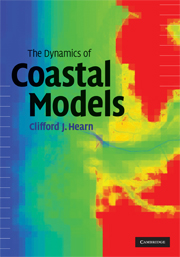Book contents
- Frontmatter
- Contents
- Preface
- Acknowledgements
- Note on mathematics and model codes
- 1 Prelude to modeling coastal basins
- 2 Currents and continuity
- 3 Box and one-dimensional models
- 4 Basic hydrodynamics
- 5 Simple hydrodynamic models
- 6 Modeling tides and long waves in coastal basins
- 7 Mixing in coastal basins
- 8 Advection of momentum
- 9 Aspects of stratification
- 10 Dynamics of partially mixed basins
- 11 Roughness in coastal basins
- 12 Wave and sediment dynamics
- References
- Index
- References
11 - Roughness in coastal basins
Published online by Cambridge University Press: 18 December 2009
- Frontmatter
- Contents
- Preface
- Acknowledgements
- Note on mathematics and model codes
- 1 Prelude to modeling coastal basins
- 2 Currents and continuity
- 3 Box and one-dimensional models
- 4 Basic hydrodynamics
- 5 Simple hydrodynamic models
- 6 Modeling tides and long waves in coastal basins
- 7 Mixing in coastal basins
- 8 Advection of momentum
- 9 Aspects of stratification
- 10 Dynamics of partially mixed basins
- 11 Roughness in coastal basins
- 12 Wave and sediment dynamics
- References
- Index
- References
Summary
Introduction
Roughness or rugosity has a major role in models of coastal basins at a variety of spatial scales. It is defined in the most general sense as a stochastic variation in the profile of the surface that defines the interface between two media. An example is the roughness of the seabed, and another is the roughness of a coastline. Both of the terms roughness and rugosity are in common use, although the latter does have a quantitative definition as the ratio of the true surface area to the geometric area of the interface. For example, the geometric area of the Earth is that of a sphere (or more precisely an oblate spheroid), whereas the true surface area involves the Earth's complex topography. In reality, the value obtained for the surface area depends on the spatial scale that we use, and this is discussed in more detail later in this chapter. So, rugosity is well defined if we specify the spatial scale at which we measure the true area. This idea can also be used in one dimension and, for example, a chain can be placed over a coral reef to measure the length its surface and this is then compared with the horizontal distance between the points measured with a surveyors tape. The result clearly depends on the length of the links in the chain but is a traditional survey tool for measuring rugosity.
- Type
- Chapter
- Information
- The Dynamics of Coastal Models , pp. 394 - 435Publisher: Cambridge University PressPrint publication year: 2008



